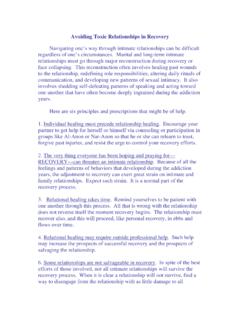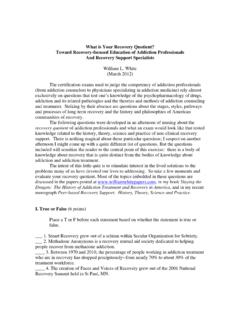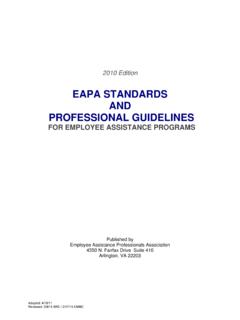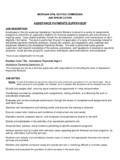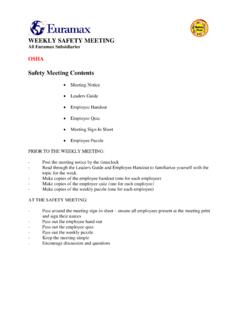Transcription of The Evolution of Employee Assistance: A Brief …
1 1 The Evolution of Employee assistance : A Brief History and Trend Analysis By William White, , David Sharar, , PhD Candidate Workplace responses to employees experiencing performance-impairing problems have undergone remarkable changes over the past 250 years. This paper: 1) describes the Evolution of such responses through five historical periods, 2) analyzes the major trends across these periods, and 3) speculates on the future directions of Employee assistance (EA) as a professionalized endeavor. It is our hope that this paper will stir discussion and debate about the EA field s evolving identity and its future as a professional specialty.
2 The History of Employee assistance Alcohol Promotion/Suppression. Alcohol was integrated into the early American workplace as it was integrated into all aspects of American colonial life. Concern about problems created by alcohol-impaired workers grew as per capita alcoholic consumption rose dramatically between 1790 and 1830 (Rorabaugh, 1979). The resulting temperance movement played a major role in removing alcohol from the workplace and sobering up the American workforce. By the end of the nineteenth century, this major cultural movement and the growing awareness of alcohol-related accidents within the country s increasingly mechanized industries combined to suppress the open use of alcohol in the workplace.
3 It was then that concern shifted from alcohol consumption by all workers to the problem of a small number of workers for whom alcohol continued to produce significant impairments in productivity and health (Levine, 1978). Informal Paternalistic Intervention The first significant efforts of organizations to help individual employees resolve alcoholism and other personal problems that might impair their performance began in the nineteenth century. Typical of these efforts were informal policies of police and fire departments that encouraged alcohol-impaired employees to sign a pledge of abstinence, involve themselves in temperance groups, or to undergo a period of care in an inebriate home or inebriate asylum (Baumhol, 1991).
4 One of the earliest inebriate homes, the Chicago Washingtonian Home, was birthed in 1863 out of a successful experiment of Robert Law who rehabilitating one of his alcoholic Employee by moving the Employee into Law s own home (White, 1998). Such efforts were part of the rescue work that emerged within the American temperance movement, and were aggressively pursued within companies whose leaders viewed themselves as the head of the company "family. The growth of medical and personnel departments within American business and industry grew, in part, out of such paternalism.
5 Industrial Alcoholism programs As American businesses and industries became larger and more depersonalized in the opening decades of the twentieth century, companies responded to alcohol-impaired employees in one of two ways: They were either fired, or they were retired on the job. It was in this context that occupational counseling programs rose in the 1940s. These programs were frequently rooted in the informal assistance offered to alcoholic employees by other employees who had sobered themselves through involvement in Alcoholics Anonymous (Trice and Schonbrunn, 1981; White, 2000a).
6 The desire to reach a larger number of alcohol-impaired employees led to a formalization of these efforts within companies such as Eastman Kodak, Allis Chalmers, and Kennecott Copper Company (Steele, 1989; Presnall, 1981). These more formalized programs were christened industrial (or occupational) alcoholism programs , and spread through the efforts of a rising alcoholism movement led by the Yale Center of Alcohol Studies and the National Committee on Education on Alcoholism. The Yale Plan for Business and Industry promoted a nine step plan for implementing an occupational alcoholism program.
7 1) education of top management, 2) assignment of program responsibility to an existing department, preferably the medical department, 3) selection and training of a coordinator to administer the program, 4) mobilization of internal intervention resources, 5) development of a company-wide policy regarding relationship of treatment to discipline, 6) linkage to alcoholism treatment services, 7) supervisory training, 8) Employee orientation and education, and 9) periodic surveys to assess the extent of the problem within the company (Henderson and Bacon, 1953).
8 2 Internal Employee assistance programs During the 1950s, companies such as Consolidated Edison, Standard Oil of New Jersey, and American Cyanamid extended their alcoholism programs to also cover employees that were experiencing mental health problems. This marked the beginning Evolution from industrial alcoholism programs to workplace Employee assistance programs (Presnall, 1981, Roman, 1981; Steele and Trice, 1995). The pivotal event in this transition was the establishment of an Occupational programs Branch within the National Instituted on Alcohol Abuse and Alcoholism (NIAAA) in the early 1970s.
9 Will Foster and Donald Godwin pushed the position within NIAAA that workplace intervention should not be focused on alcoholism but on the broad spectrum of behavioral health problems encountered by employees. One of the goals of NIAAA leadership from its earliest inception was to break down the stereotype of the alcoholic as a Skid Row wino and take the issue of alcoholism to the heart of middle class America (Roman, 1981). NIAAA funded two Occupational Program Consultants (OPCs) within each state whose responsibility was to organize occupational alcoholism programs in business and industry.
10 These first OPCs became known as the Thunderin Hundred, and their efforts led to a dramatic rise in the number of occupational alcoholism programs in the The emergence of occupational alcoholism as a professional specialty was marked by the 1971 founding of the Association of Labor Management Administrators and Consultants on Alcoholism (ALMACA). The rapidly evolving philosophy that guided the OPCs led first to a shift in emphasis from identifying alcoholic employees to identifying Employee performance problems and then to a transition in identity of these programs from alcoholism intervention programs to broadbrush Employee assistance programs (EAPs).







